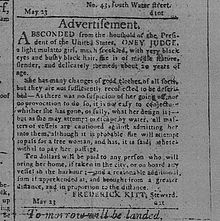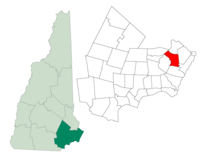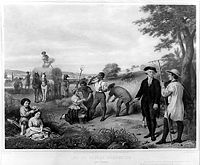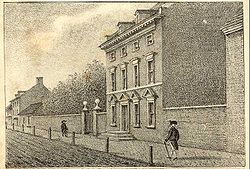- Oney Judge
-
Oney Judge 
"Advertisement," The Pennsylvania Gazette, Philadelphia, Pennsylvania, May 24, 1796.Born ca. 1773
Mount Vernon, VirginiaDied February 25, 1848 (aged 75)
Greenland, New HampshireSpouse John Staines Children Eliza Staines
Nancy Staines
Will StainesParents Andrew Judge
Betty the slaveOney "Ona" Judge, later Oney Judge Staines (c. 1773 – February 25, 1848), was a slave at George Washington's plantation, Mount Vernon in Virginia.[1] A servant in Washington's presidential households beginning in 1789, she escaped to freedom in 1796 and made her way to New Hampshire, where she lived the rest of her life.[2] More is known about her than any other of Washington's slaves because she was twice interviewed by abolitionist newspapers in the 1840s.[3]
Contents
Youth
Oney was born about 1773 to Betty, an enslaved seamstress, and Andrew Judge, a white English tailor who was an indentured servant at Mount Vernon. Her mother was one of about 85 "dower slaves" listed in the Estate of Daniel Parke Custis (1711–1757), and under the lifetime control of his widow, Martha Custis Washington. Under the legal principle known as partus, which had been incorporated into Virginia colonial law, her status as a slave was determined by that of her mother.
At about age 10, she was brought into the Mansion House at Mount Vernon, likely as a playmate for Mrs. Washington's granddaughter Nelly Custis. She eventually became Martha Washington's personal attendant or body servant.
Presidential household
She was one of seven slaves — Oney Judge, Austin, Giles, Paris, Moll, Christopher Sheels, William Lee — taken to New York City in 1789, to work in Washington's presidential household. Following the transfer of the national capital to Philadelphia in 1790, she was one of nine slaves — Oney Judge, Austin, Giles, Paris, Moll, Hercules, Richmond, Christopher Sheels, "Postilion Joe" (Richardson)[4] — to work in the President's House.[5] Austin was Oney's half-brother, about 15 years her senior.
Pennsylvania had passed an act for the gradual abolition of slavery in 1780, and prohibited nonresidents from holding slaves in the state longer than six months. If held beyond that period, the state's Gradual Abolition Act[6] gave slaves the legal power to free themselves.[7] Washington argued (privately) that his presence in Pennsylvania was solely a consequence of Philadelphia's being the temporary seat of the federal government, and that the state law should not apply to him. On the advice of his attorney general, Edmund Randolph, Washington systematically rotated the slaves serving at the President's House in and out of the state to prevent their establishing a six-month continuous residency.[8] Such a rotation was a violation of Pennsylvania law, but the president's actions were not challenged. By strict legal interpretation, a slave's residency could be terminated by spending one day outside the state. Slaveholders exploited this loophole until Pennsylvania eliminated it through a 1788 amendment to the Gradual Abolition Act. Washington repeatedly violated the amendment. He was careful to avoid spending six continuous months in Pennsylvania (which might have been interpreted as his establishing legal residency), arguing that he remained a citizen of Virginia, and subject to its laws regarding slavery.[9]
Washington was on his Southern tour in May 1791 when the first six-month deadline approached. To interrupt their Pennsylvania residency, Martha Washington took Oney and Christopher Sheels to Trenton, New Jersey for two days,[10] and sent other slaves back to Mount Vernon prior to the deadline to prevent their obtaining freedom.[8]
Escape
According to the 1845 interview, Oney fled after learning that the First Lady had promised her as a wedding present to her granddaughter Eliza Custis:
"Whilst they were packing up to go to Virginia, I was packing to go, I didn't know where; for I knew that if I went back to Virginia, I should never get my liberty. I had friends among the colored people of Philadelphia, had my things carried there beforehand, and left Washington's house while they were eating dinner."[11]
Runaway advertisements establish that she escaped to freedom from the President's House on Saturday, May 21, 1796. The following appeared in The Pennsylvania Gazette on Tuesday, May 24, 1796:
Advertisement. Absconded from the household of the Presi- dent of the United States, ONEY JUDGE, a light mulatto girl, much freckled, with very black eyes and bushy hair. She is of middle stature, slender, and delicately formed, about 20 years of age. She has many changes of good clothes, of all sorts, but they are not sufficiently recollected to be descri- bed—As there was no suspicion of her going off, nor no provocation to do so, it is not easy to conjecture whither she has gone, or fully, what her design is; but as she may attempt to escape by water, all mas- ters of vessels are cautioned against admitting her into them, although it is probable she will attempt to pass for a free woman, and has, it is said, where- withal to pay her passage. Ten dollars will be paid to any person who will bring her home, if taken in the city, or on board any vessel in the harbour;—and a reasonable additional sum if apprehended at, and brought from a greater distance, and in proportion to the distance. FREDERICK KITT, Steward. May 23
New Hampshire
John Langdon House, Portsmouth, New Hampshire. Over a September 1798 dinner, Burwell Bassett Jr. revealed his plan to kidnap Oney.
Judge was hidden by friends and put aboard the Nancy, a ship bound for Portsmouth, New Hampshire. That summer she was recognized on the streets of Portsmouth by Senator John Langdon's daughter Elizabeth, a friend of Nelly Custis. Washington knew of Oney's whereabouts by September 1, when he wrote to Oliver Wolcott, Jr., the Secretary of the Treasury, about having her captured and returned by ship.[12] Joseph Whipple, Portsmouth's collector of customs, interviewed her and reported back to Wolcott and the President. They abandoned their plan after Whipple warned that news of an abduction could cause a riot on the docks. Whipple said that he would not remove Judge against her will, but relayed her offer to return voluntarily to the Washingtons if they would guarantee her freedom following their deaths.[13]
Washington responded:
"I regret that the attempt you made to restore the Girl (Oney Judge as she called herself while with us, and who, without the least provocation absconded from her Mistress) should have been attended with so little Success. To enter into such a compromise with her, as she suggested to you, is totally inadmissible, for reasons that must strike at first view: for however well disposed I might be to a gradual abolition, or even to an entire emancipation of that description of People (if the latter was in itself practicable at this moment) it would neither be politic or just to reward unfaithfulness with a premature preference [of freedom]; and thereby discontent before hand the minds of all her fellow-servants who by their steady attachments are far more deserving than herself of favor."[14]
Washington retired from the presidency in March 1797. The next year his nephew Burwell Bassett Jr. traveled to New Hampshire in September 1798, to try to convince Judge to return. By this point, she had married and was the mother of an infant; her husband was at sea. Judge met with Bassett, but refused to return to Virginia with him. Over dinner with Senator Langdon, Bassett revealed his plan to kidnap her. Langdon secretly sent word for Judge to go into hiding, and foiled Bassett's plan.[15]
Washington could have used the federal courts to recover Oney — the 1793 Fugitive Slave Act (which he had signed into law) required a legal process to return an escaped slave over state lines. Any court case, however, would have been part of the public record, and attracted unwelcome attention.
Following Oney's escape, her younger sister, Delphy (born about 1779),[16] became the wedding present to Martha Washington's granddaughter. Delphy and her children were manumitted in 1807.[17]
Family
 Town of Greenland, Rockingham County, New Hampshire.
Town of Greenland, Rockingham County, New Hampshire.
In New Hampshire, Oney met and married John (Jack) Staines, a free black sailor. Their January 1797 marriage was listed in the town records of Greenland and published in the local newspaper.[18] They had three children:
- Eliza Staines (born 1798, died February 14, 1832, New Hampshire, no known offspring)
- Will Staines (born 1801, death date & location unknown, no known offspring)
- Nancy Staines (born 1802, died February 11, 1833, New Hampshire, no known offspring)
Oney and John Staines had fewer than 7 years together; he died on October 19, 1803. Alone, she was unable to support their children and moved back with the family of John Jacks. She and his sisters were supported by the community after his death.[15] Later Eliza and Nancy were made wards of the town and hired out as indentured servants;[19] As a young man, Will was apprenticed as a sailor, and reportedly never returned to Portsmouth.[15]
Interviews on slavery
Oney Judge Staines' interviews in May 1845 in The Granite Freeman and January 1847 in The Liberator, both abolitionist newspapers, contained a wealth of details about her life. She described the Washingtons, their attempts to capture her, her opinions on slavery, her pride in having learned to read, and her strong religious faith. When asked whether she was sorry that she left the Washingtons, since she labored so much harder after her escape than before, she said: "No, I am free, and have, I trust been made a child of God by the means."[20]
Never freed
Oney Judge was not among the 124 "Washington" slaves freed under the terms of George Washington's will, following his 1799 death.[21] Instead, the 153 or so "dower" slaves reverted to the Custis Estate following Martha Washington's 1802 death, and they were divided among her grandchildren.[22]
Legally, Oney's children also were "dower" slaves, property of the Custis Estate, although their father had been a free man and they had been born in New Hampshire.[23]
The Fugitive Slave Act of 1793 established the legal mechanism by which a slaveholder could recover his property, a right guaranteed in the U.S. Constitution by the Fugitive Slave Clause (Article IV, Section 2). The 1793 Act — passed overwhelmingly by Congress and signed into law by Washington — made it a federal crime to assist an escaped slave. It overruled state and local laws that provided escaped slaves with sanctuary, and allowed slavecatchers into every U.S. state and territory.
Practically, after Washington's death, Judge Staines felt secure in New Hampshire, as no one else was likely to mount an effort to take her.[15] But legally, she and her children remained fugitives until their deaths. Oney Judge Staines died in Greenland, New Hampshire on February 25, 1848.
In popular culture
Oney Judge life story has inspired other works:
- Thirst for Freedom by Emory Wilson (2000 drama), performed at Player's Ring Theater, Portsmouth, NH.
- Taking Liberty by Ann Rinaldi (2002 novel).
- The Escape of Oney Judge by Emily Arnold McCully (2007 children's book).
- A House with No Walls by Thomas Gibbons (2007 drama), performed at InterAct Theater, Philadelphia, PA, and regional theaters throughout the United States.
- My Name Is Oney Judge by Diane D. Turner (2010 children's book).
- Parallel Destinies by choreographer Germaine Ingram, composer Bobby Zankel, and visual artist John Dowell (2010 dance/theater piece), work-in-progress at the Philadelphia Folklore Project.
On February 25, 2008, the 160th anniversary of Judge Staines' death, Philadelphia celebrated the first "Oney Judge Day" at the President's House site. The ceremony included speeches by historians and activists, a proclamation by Mayor Michael A. Nutter, and a memorial citation by the City Council.[24]
"Oney Judge Freedom Day," the 214th anniversary of her escape to freedom, was celebrated at the President's House site on May 21, 2010.[25]
The President's House Commemoration, at 6th & Market Streets in Philadelphia, opened in December 2010. It includes a video about Oney Judge and information about all the known slaves at the house.[26]
Stand-up comedian Jen Kirkman recounts her recollections of Oney Judge's life in the Funny or Die produced web video.[27]
See also
- Samuel Osgood House (New York City) — First Presidential Mansion.
- Alexander Macomb House (New York City) — Second Presidential Mansion.
References
- ^ The February 18, 1786 Mount Vernon slave census lists "Oney" as Betty's child and "12 yrs. old". Donald Jackson and Dorothy Twohig, eds., The Diaries of George Washington, vol. 4, (Charlottesville, VA: University Press of Virginia), p. 278.
- ^ Runaway advertisement, The Pennsylvania Gazette (Philadelphia), May 24, 1796.
- ^ Two 1840s interviews with Oney Judge, President's House, US History. In the interviews, her first name is spelled "O-N-A", but all prior references spell it "O-N-E-Y".
- ^ Joe's wife Sarah took the surname Richardson after she was freed by Washington's will. Joe was a "dower" slave and was not freed.
- ^ The President's House in Philadelphia, US History.org
- ^ Pennsylvania's Gradual Abolition Act (1780), President's House of Philadelphia, US History.org
- ^ Enslaved minors were legally freed under the Act for the Gradual Abolition of Slavery, but required to work as indentured servants until they attained their majority, age 28.
- ^ a b Edward Lawler Jr.,. "Washington, the Enslaved, and the 1780 Law". President's House of Philadelphia. US History.org. http://www.ushistory.org/presidentshouse/slaves/washingtonand8.htm. Retrieved 11 February 2011.
- ^ 1788 amendment, President's House of Philadelphia, US History.org
- ^ Gen. Philemon Dickinson House
- ^ "Washington's Runaway Slave", The Granite Freeman, Concord, New Hampshire (May 22, 1845); President's House in Philadelphia, Independence Hall Association, as ushistory.org, accessed 11 February 2011
- ^ George Washington to Oliver Wolcott, Sept. 1, 1796
- ^ Joseph Whipple to Oliver Wolcott, October 4, 1796, Library of Congress
- ^ Washington to Whipple, November 28, 1796.
- ^ a b c d Eva Gerson, "Ona Judge Staines: Escape from Washington", 2000, Black History, SeacoastNH
- ^ Delphy is listed as "6 yrs. old" in the February 18, 1786 Mount Vernon slave census. Jackson & Twohig, Diaries, vol. 4, p. 278.
- ^ Washington, D.C. Land Records, Liber H, #8, p. 382; Liber R, #17, p. 288, as quoted in Henry Wiencek, An Imperfect God: George Washington, His Slaves, and the Creation of America (New York: Farrar, Straus and Giroux, 2003), p. 383, n.13.
- ^ Fritz Hirschfeld, George Washington and Slavery: A Documentary Portrayal (University of Missouri, 1997), pp. 112-17.
- ^ Evelyn Gerson, A Thirst for Complete Freedom: Why Fugitive Slave Ona Judge Staines Never Returned to Her Master, President George Washington (M.A. thesis, Harvard University, June 2000), p. 130.
- ^ "Washington's Runaway Slave", The Granite Freeman, Concord, New Hampshire (May 22, 1845), President's House, Independence Hall Association, US History.org, accessed 11 February 2011
- ^ Last Will and Testament of George Washington, George Washington Collection, PBS
- ^ The numbers of "Washington" and "dower" slaves come from the 1799 Mount Vernon slave census., George Washington Papers, University of Virginia
The names of the "dower" slaves inherited by each of the Custis grandchildren have never been published, creating an obstacle for genealogists. - ^ The legal status of a child born following an enslaved mother's escape to another (free) state was the same as if that child had been born in the mother's native (slave) state. The U.S. Constitution protected the property rights of the slaveholder, which superseded the parental rights of the child's father. See U.S. Supreme Court, Jones vs. Van Zandt (1847).
- ^ Stephan Salisbury, "City honors Washington's slave - and 'power of archaeology'", The Philadelphia Inquirer, February 26, 2008, on President's House of Philadelphia, US History.org
- ^ "Slave's escape commemorated at President's House", The Philadelphia Inquirer, May 21, 2010
- ^ "The President's House: Freedom and Slavery in the Making of a New Nation", City of Philadelphia, accessed 11 February 2011
- ^ "Drunk History vol. 3".
External links
- Two 1840s interviews with Oney Judge, US History, President's House
- (Video) Silent No Longer: The Story of Oney Judge, Philadelphia Inquirer
Sister projects
 Works related to George Washington's correspondence with Joseph Whipple at WikisourceCategories:
Works related to George Washington's correspondence with Joseph Whipple at WikisourceCategories:- 1773 births
- 1848 deaths
- American people of English descent
- American slaves
- Custis family of Virginia
Wikimedia Foundation. 2010.



